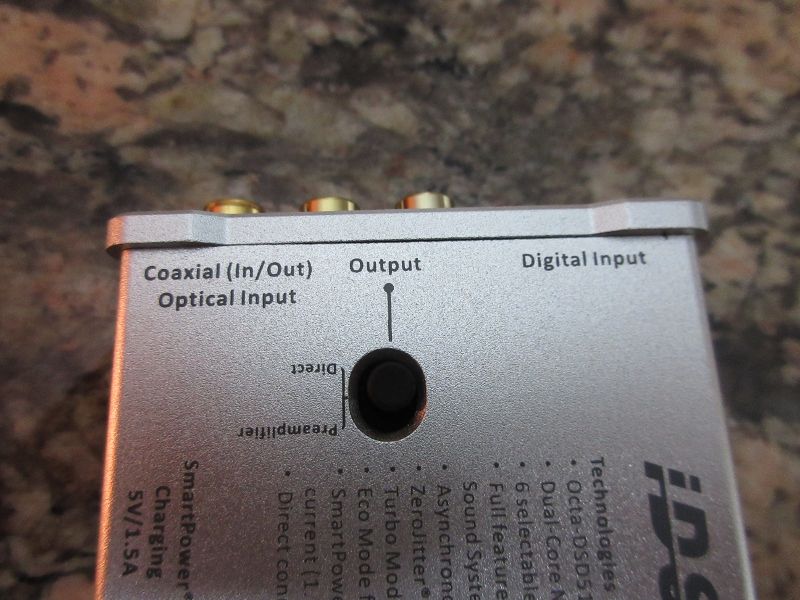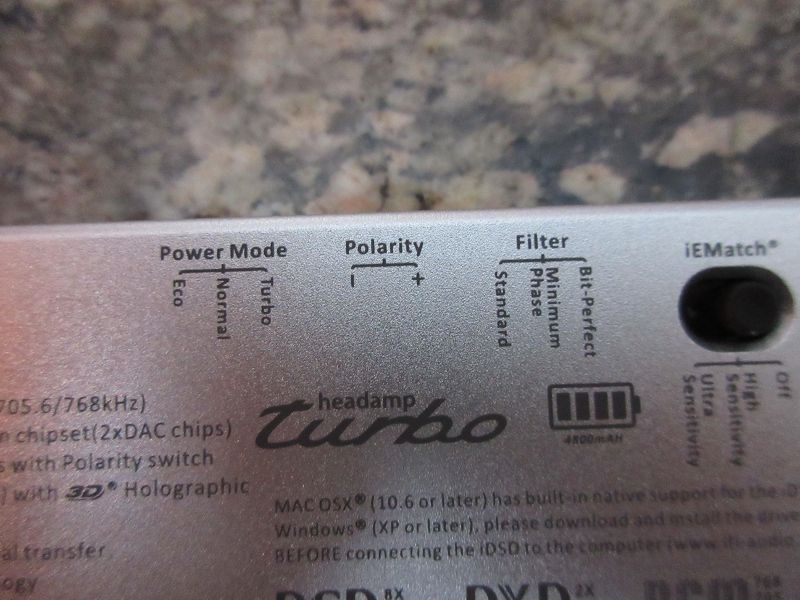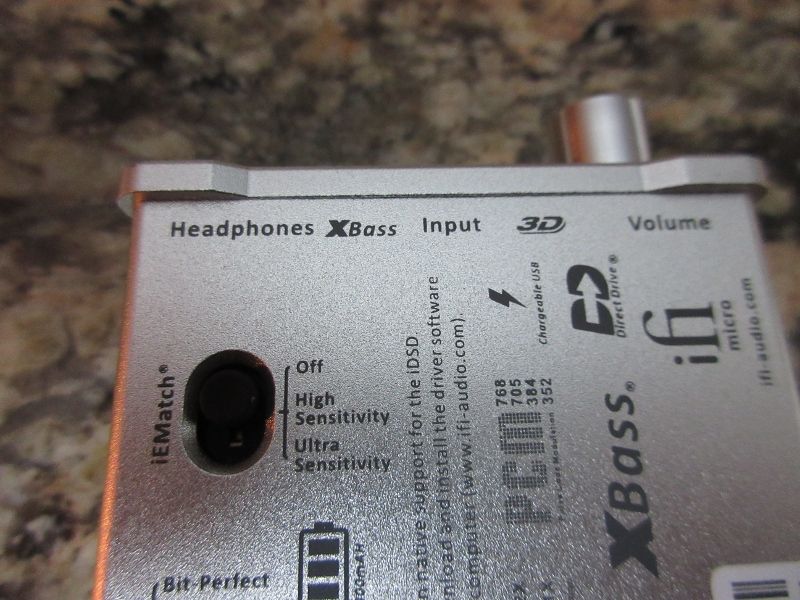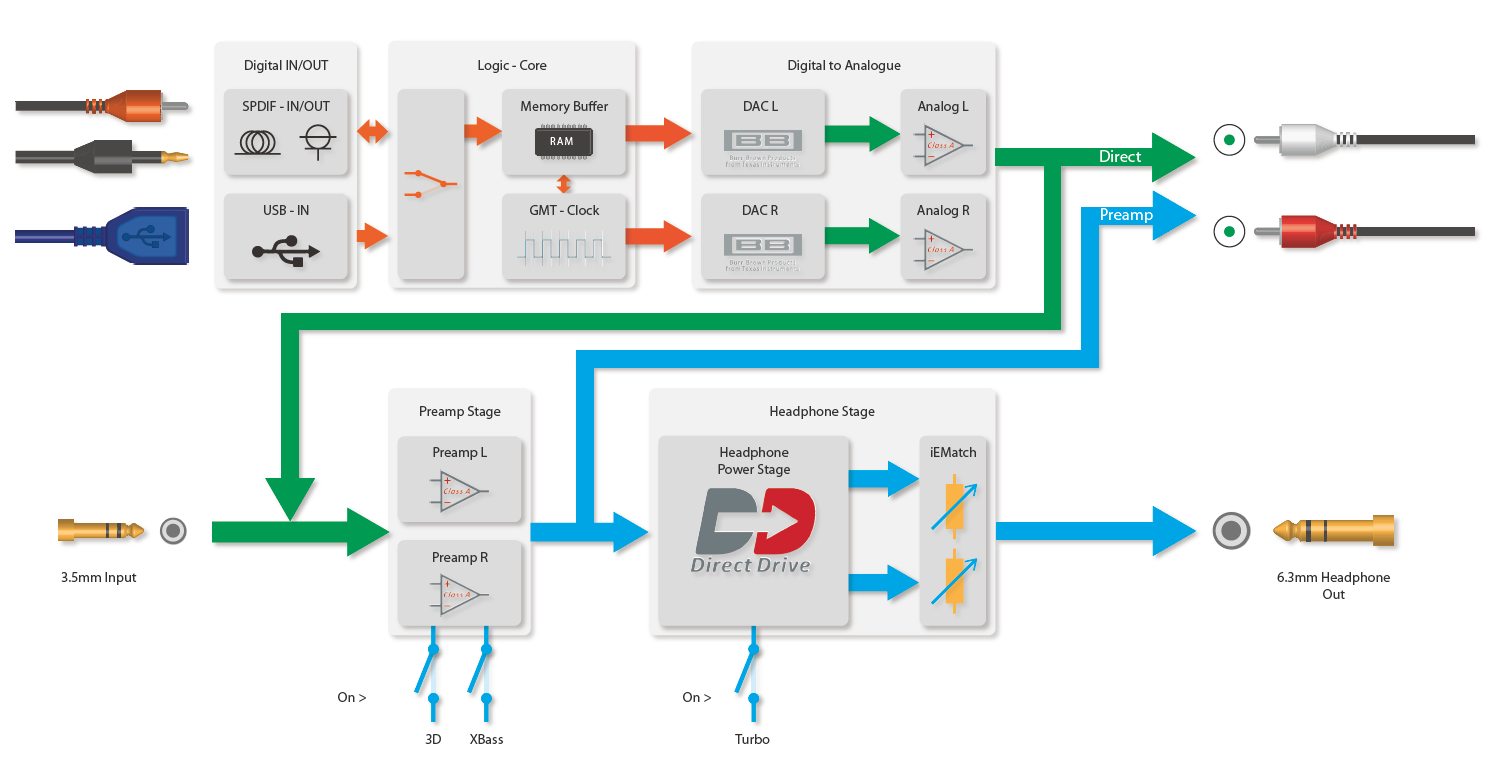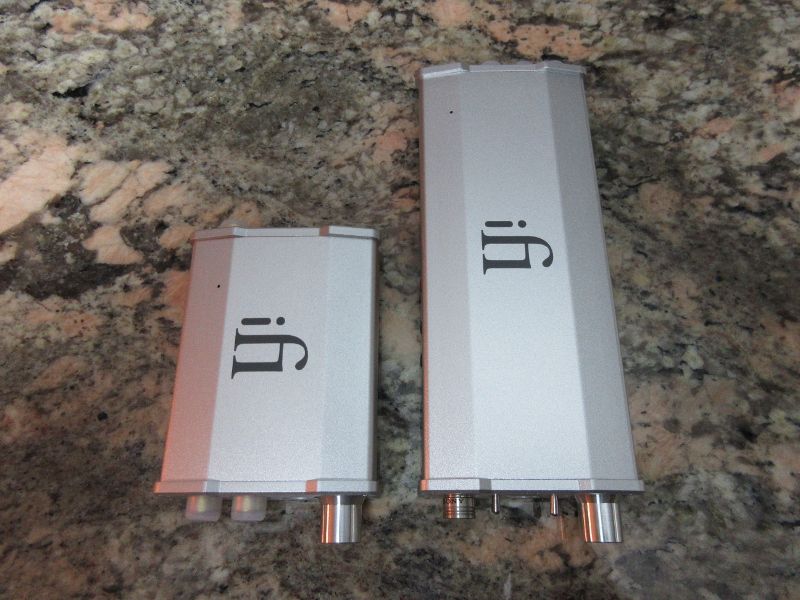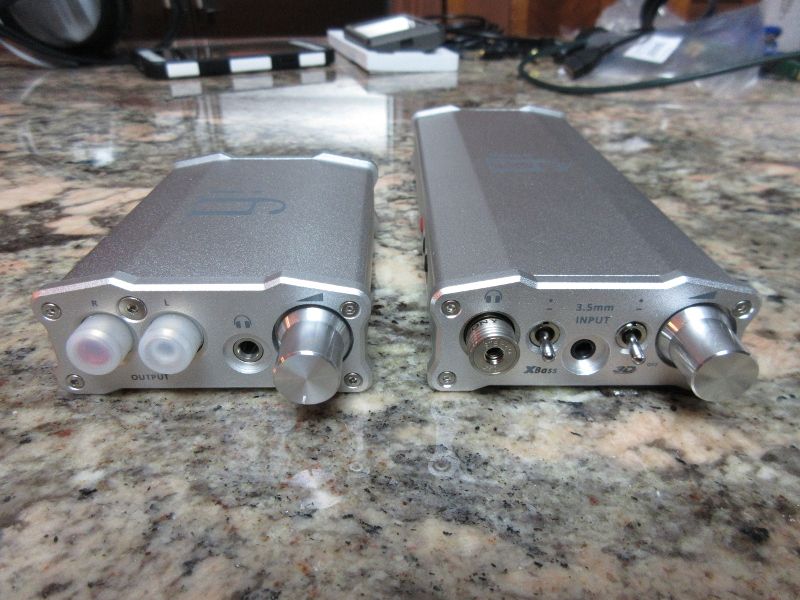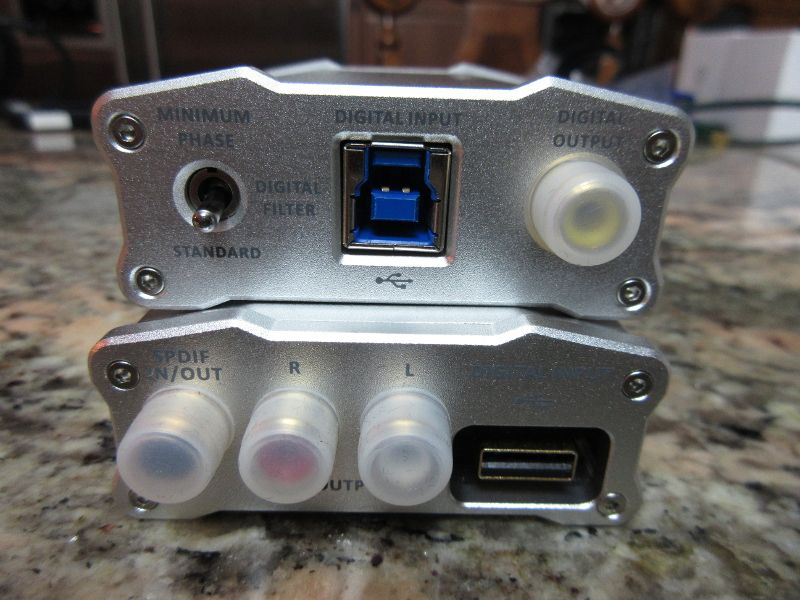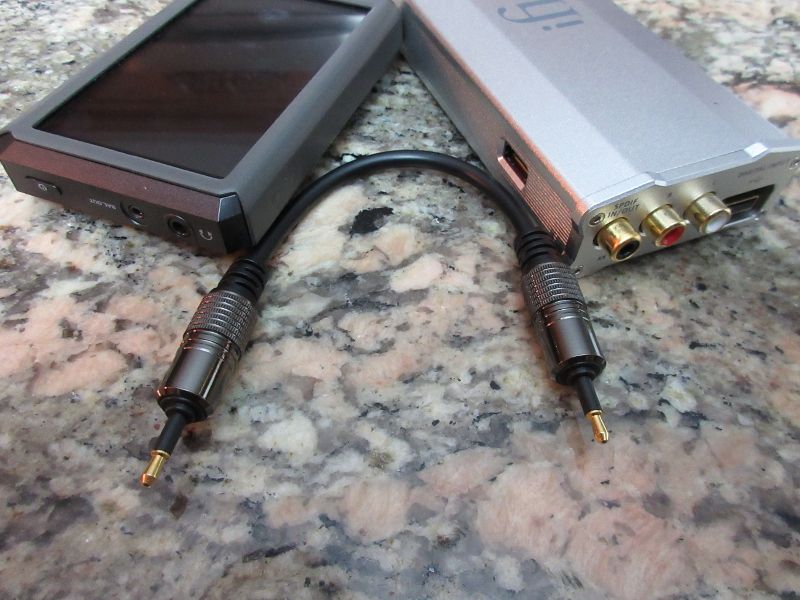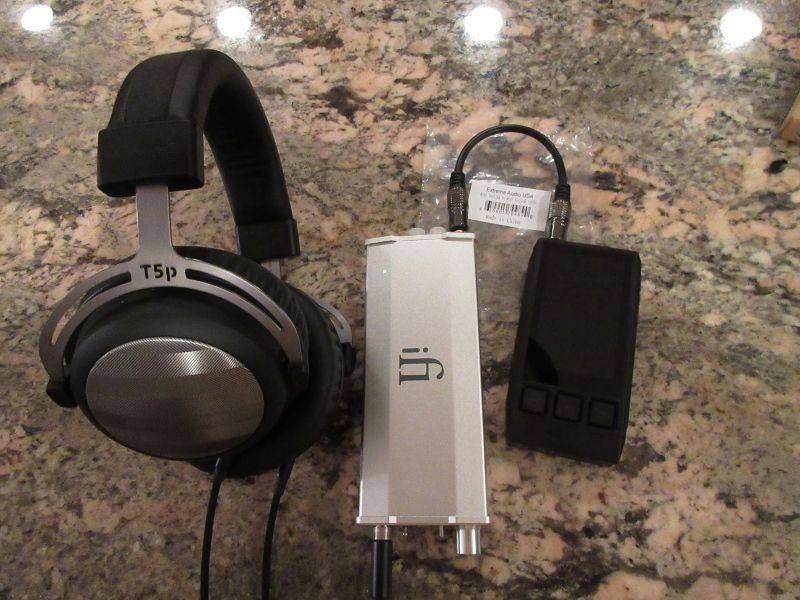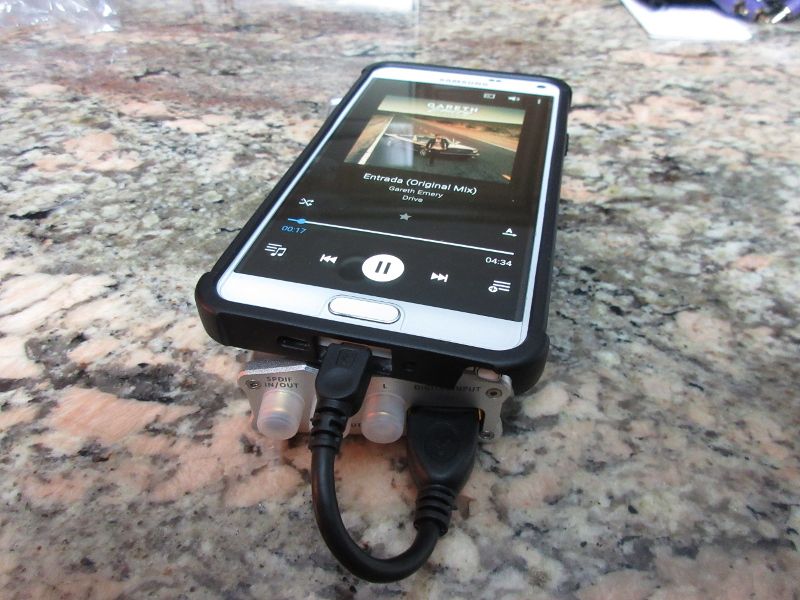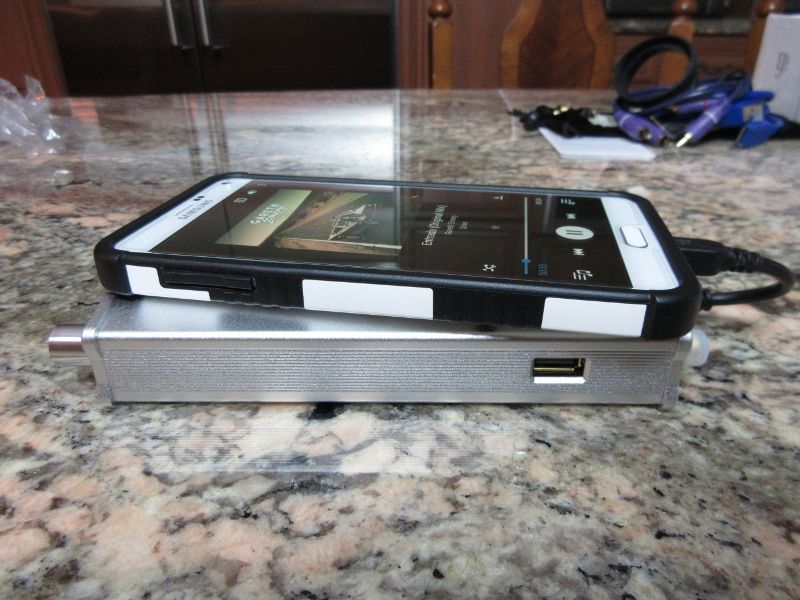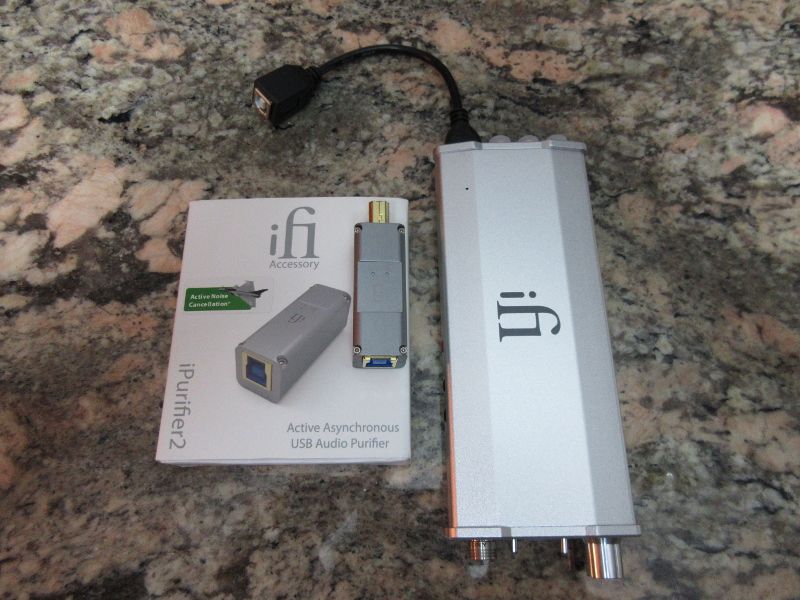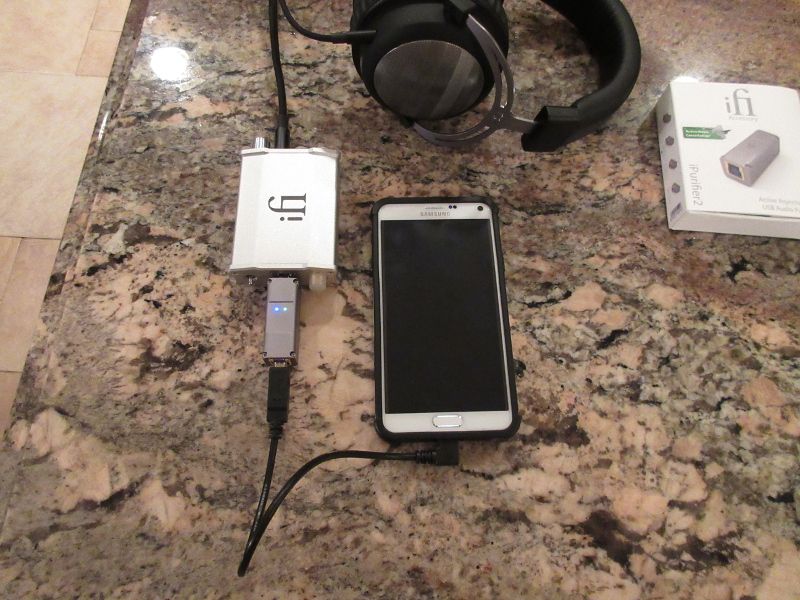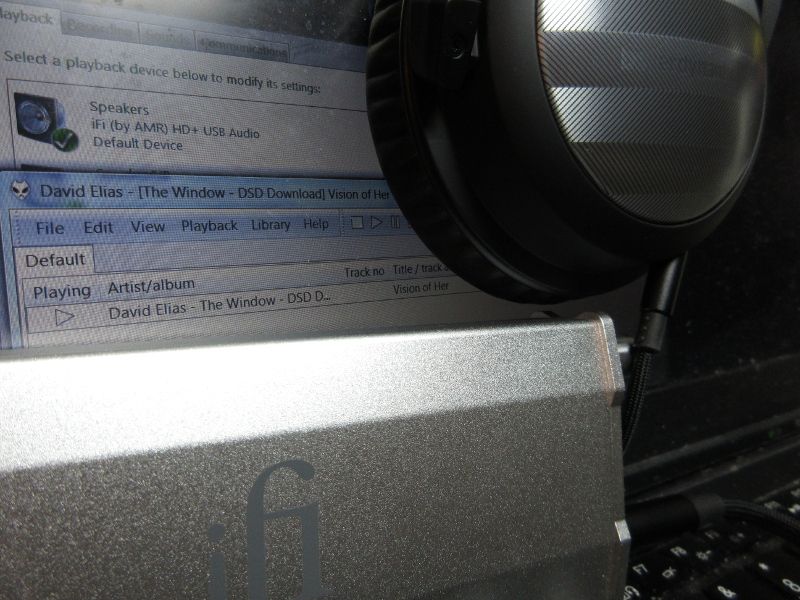This is a review of iFi Micro iDSD USB DAC/headphone amp. http://ifi-audio.com/portfolio-view/micro-idsd/, also available on Amazon: http://www.amazon.com/dp/B00M50FLWK/.
I’m probably starting to sound like a broken record every time I mention about my preference of a portable audio setup where all I need is a small pocket-able DAP and a pair of IEMs for listening on the go. But as a reviewer, I try to be more open-minded and step outside of the portable gear circle to get my feet wet exploring full size headphones, portable and usb DACs/amps and even some desktop DACs/amps. Desktop setup for me is a real stretch because when I’m ready to sit down, my preferred listening environment is our family room couch, when our young ones are finally in bed and my wife next to me getting her daily dose of social media updates (thus a no open-back headphone policy lol!). At that point, I can stack up my DAP with a portable amp or hook up USB DAC to my aging ThinkPad to boost its audio performance.
Obviously, while using my DAP or my laptop as a source, I’m not going to drag a desktop amp on to the couch. Also, using some of my smaller usb DACs offers only a marginal improvement and can’t support all high res sampling rates, plus many of these are underpowered to drive higher impedance or planar magnetic full-size headphones to their full potential. It feels like I have to either compromise or to use different pieces of equipment to meet my needs because I want something that could be reasonably transportable, could drive everything from sensitive monitors to more demanding cans, and will support all popular hi-res formats. Add to this a wish for a great sound quality and not to be at a mercy of noisy 5V usb VBUS. Is this too much to ask? I thought it was until I got a chance to review iFi micro iDSD. Is this too good to be true? Let’s see what I found over the last few weeks of using this true Swiss Army Knife of semi-portable audio gear.
Unboxing.
Greeted with a nice cover shot of all aluminum Micro, my attention zoomed right into the description underneath of it with “Octa-Speed DSD512, Double-Speed DXD, and PCM 32bit/768kHz”. You know right away this is going to be one serious piece of audio equipment with some major horse power under the hood. As I continued with my tour of the box exterior, turning it on the side revealed more details about Dual-Core Burr Brown chipset supporting True Native DSD and Bit Perfect DXD/PCM, a powerful 8Vrms/4W (into 16 ohm) output, 3D holographic sound system and XBass effects, and even 1.5A external charging port for your smartphone or tablet. But wait till you get to the back of the box and start reading every bullet in the Technologies and Specifications list underneath of a detailed drawing of Micro from every side. To describe it as “impressive” would be an understatement, and the only thing missing in there was a kitchen sink, and that was probably because they ran out of room.
Even before getting my hands on it, I was already feeling overwhelmed trying to decide what I am going to test first when I get Micro out of the box. The box was inside of the outer sleeve with all the printed info, and sliding it off revealed an all white “apple” quality cardboard box with silver iFi letters on top. With a cover off, now I was able to see Micro in all its glory, wedged inside of a secure foam cutout. My first impression was “Wow!!!” It looked bigger than I expected and had a shape reminding me of a car amp unit. I also felt a very solid aluminum shell and a noticeable heft as I removed Micro in order to get to the bottom of the box where all the accessories were stored across two partitioned sections. While in many cases I appreciate the actual experience of unboxing the product, here my highlight was reading a detailed Spec list which builds up the anticipation!
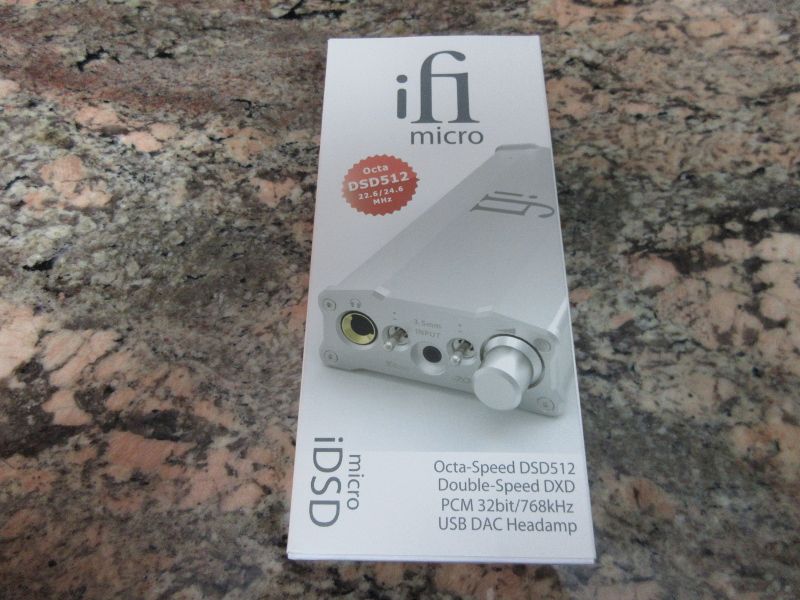
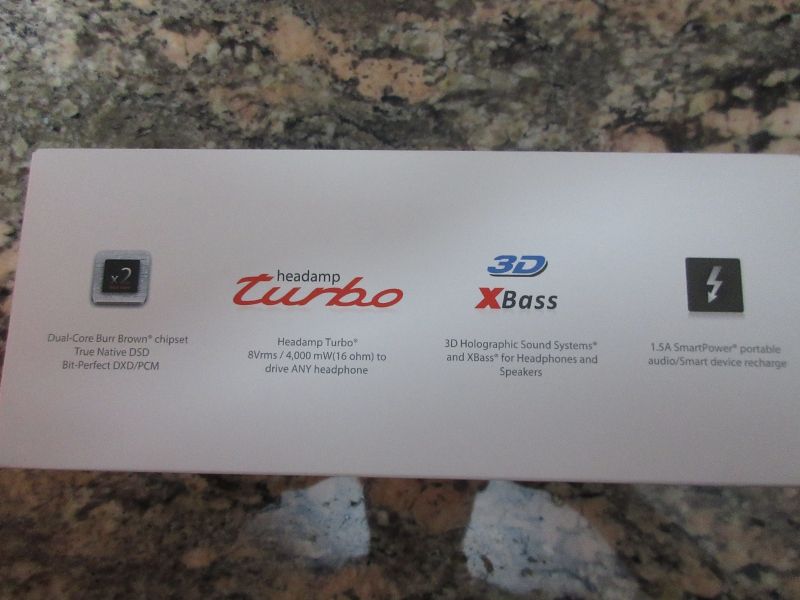
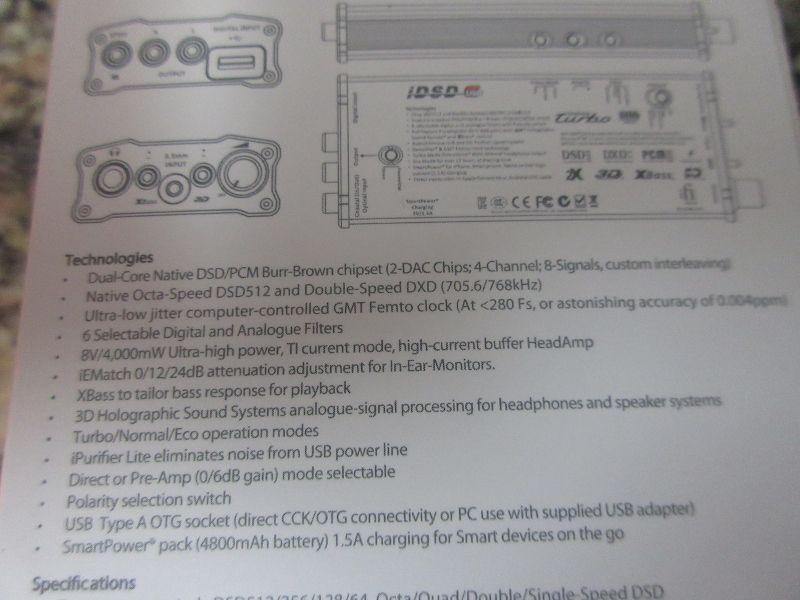
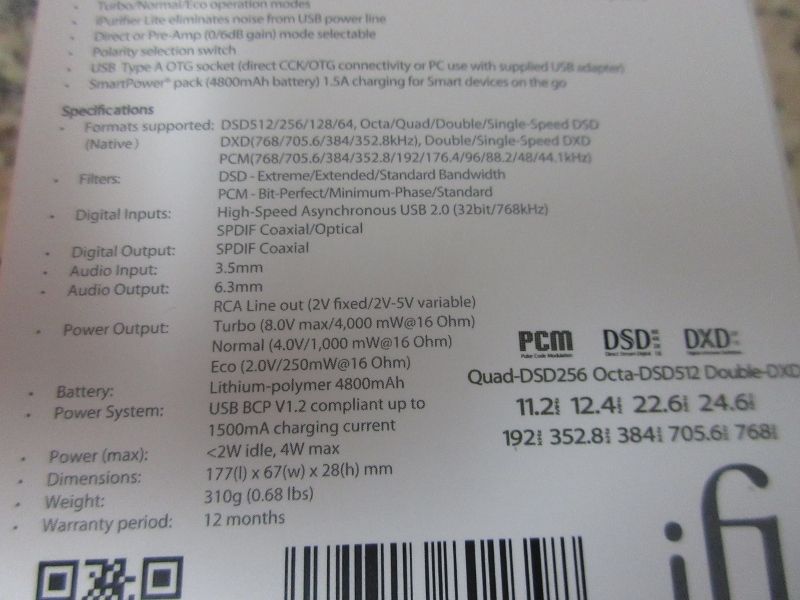
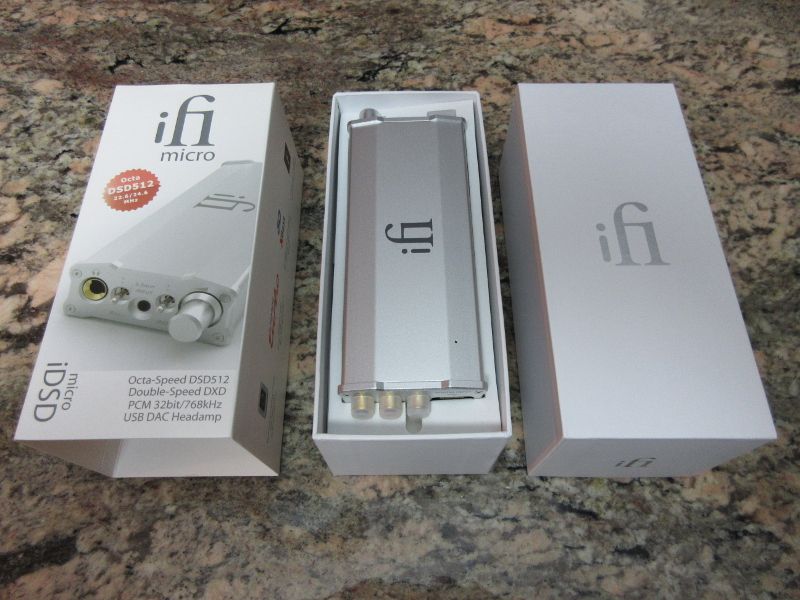
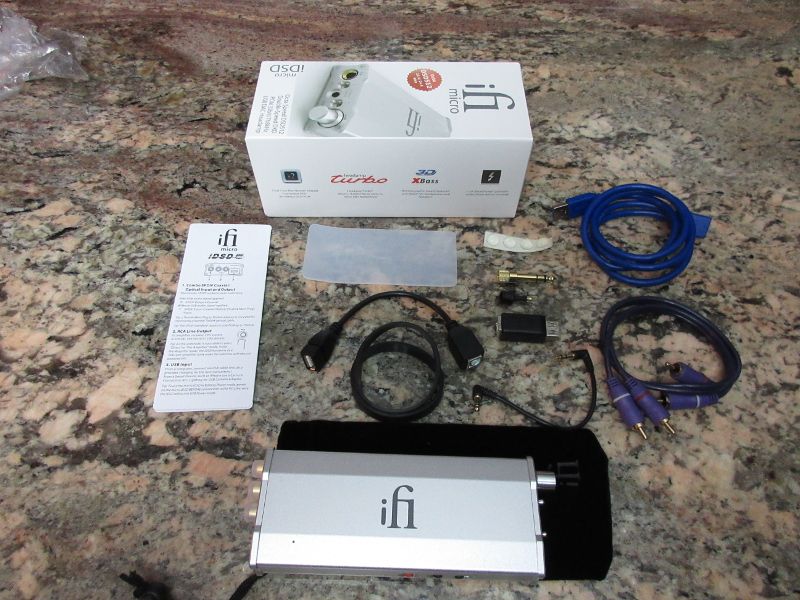
Accessories.
As much as I couldn’t wait to get to Micro, I had to set it aside and move on to examine the accessories. First of all there was a detailed manual, very important in this case since Micro is full of surprises you can easily miss. Then, you have 4 clear rubber stick on bumps to use under the iDSD for additional friction and/or to prevent surface from scratches, and also a semi-transparent rubbery pad to use with iDSD when you stacking it with another device (smartphone, tablet, DAP, etc). You also get 1/4” to 3.5mm adapter since iDSD has 1/4” HO. With all aluminum/silver body finish I personally didn’t like the look of a gold adapter sticking out of the socket, so I found a shallow silver one as a replacement (PC-234S model). Also, iFi included a velour drawstring storage/protection pouch and 2 mounting rubber bands to secure transport/source devices to Micro.
Moving on to cables, you will find a dual RCA high quality cable, and I really mean HIGH quality! You also get a short 3.5mm to 3.5mm interconnect cable to use Micro as amplifier from your source. Next is the USB-A to USB-B socket adapter cable and another short adapter to accommodate Micro’s USB-A connector on the back since many audio digital cables are usb-a to usb-b. Also, you get a high quality USB-A socket to USB-A connector cable to attach Micro directly to you computer. And if that wasn’t enough, they also included Toslink to mini 3.5mm optical adapter since Micro’s Coax port is combined with optical input. Only one adapter was included, though I would have preferred a pair in order to transform a common Toslink cable.
This was a very impressive collection of accessories, and I’m not talking about cheap fillers, but the actual high quality cables and other goodies. The only thing I would add is a short OTG adapter cable, typical USB-A socket to micro-USB connector for Android devices, and a camera adapter kit cable for iPhone/iPad devices. Micro supports USB OTG connection and with USB-A connector on the back you can go directly with a short adapter cable to your smartphone or tablet.
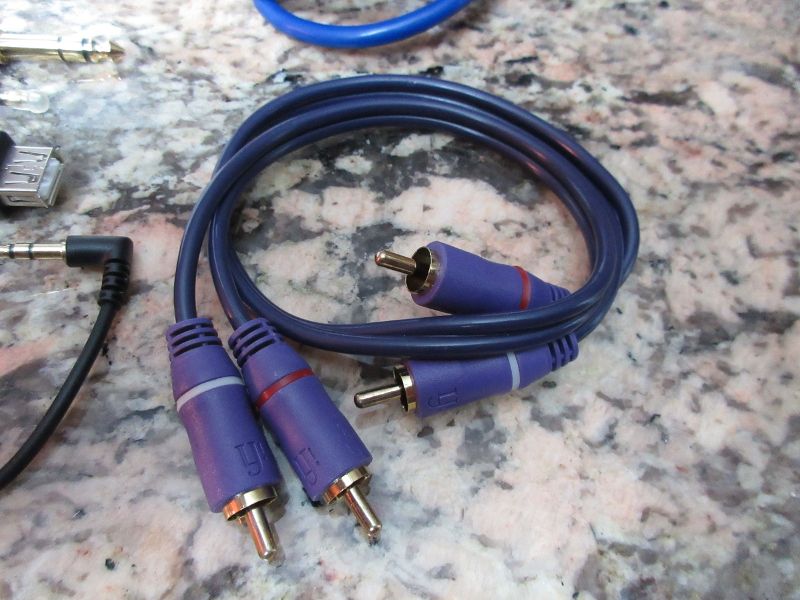
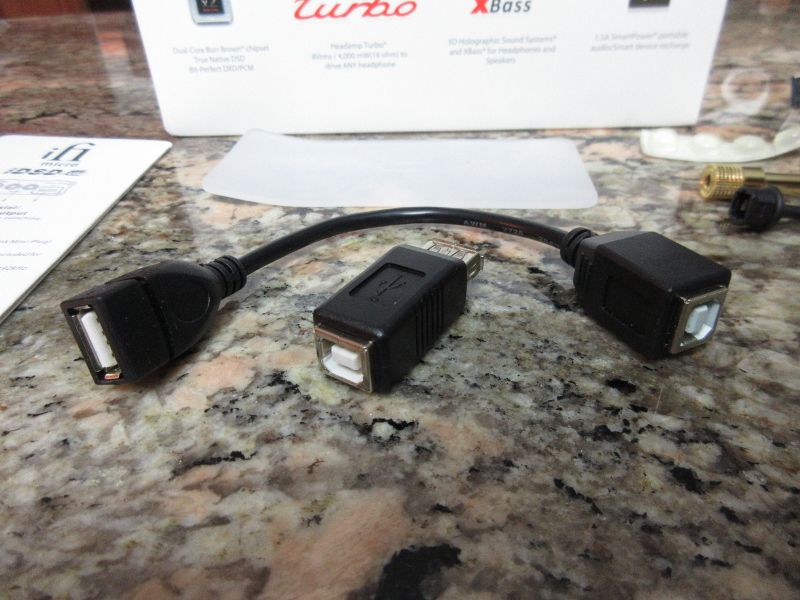
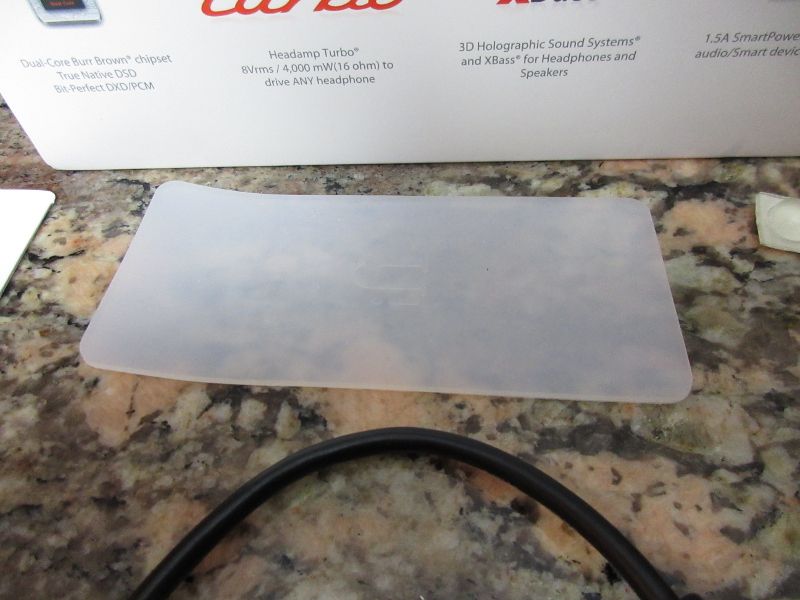
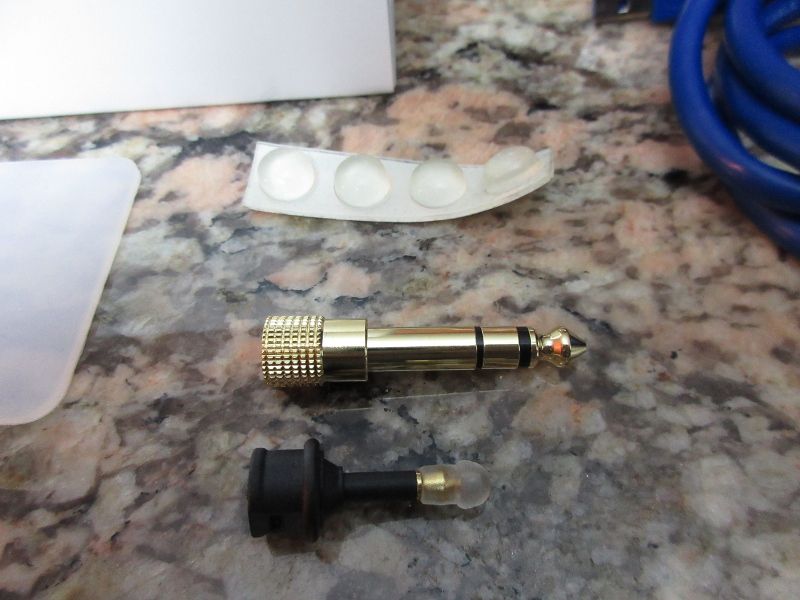
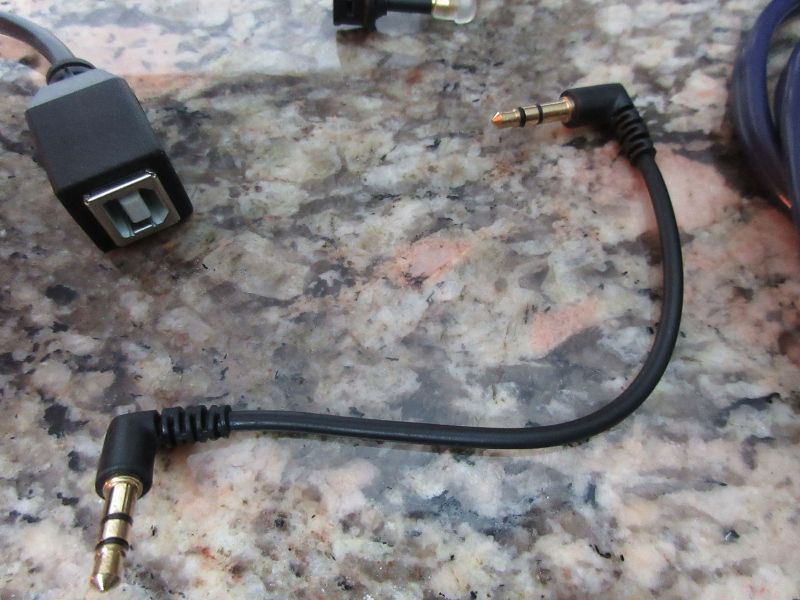
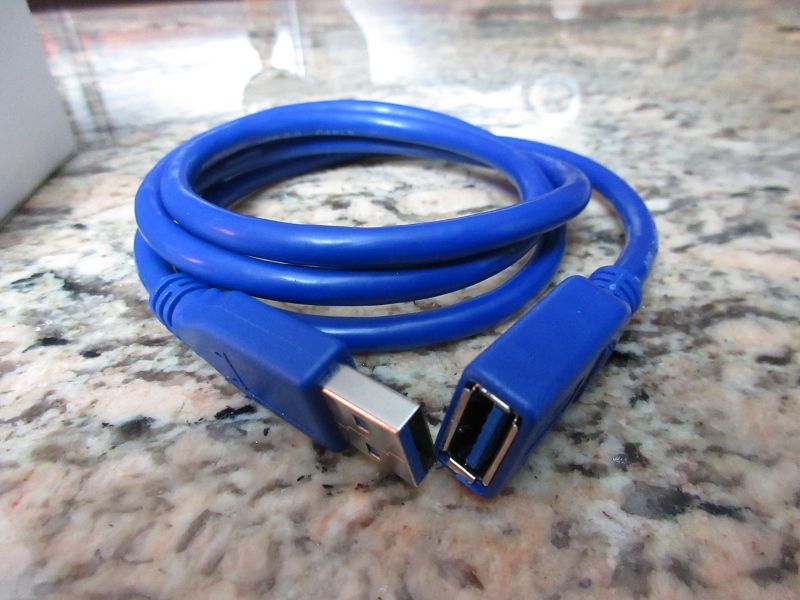
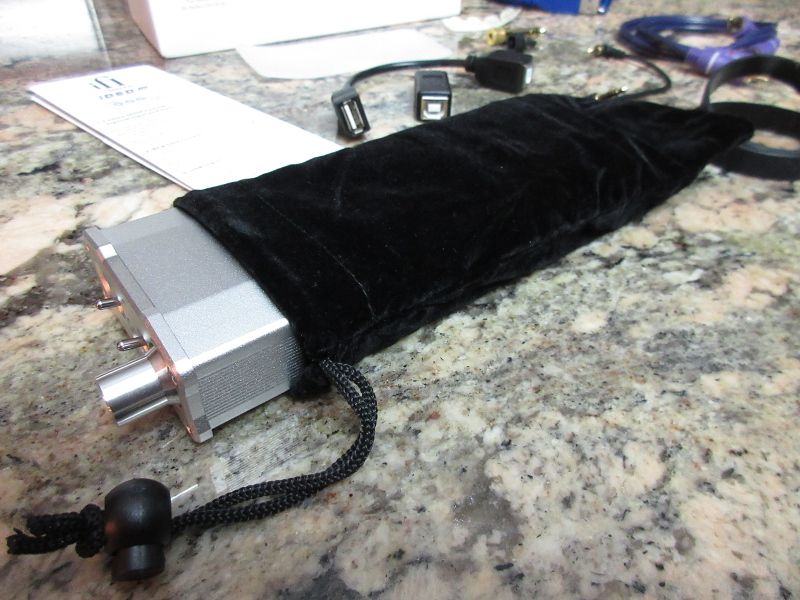
PC-234S replacement 1/4" to 3.5mm adapter (not included, search for it on eBay):
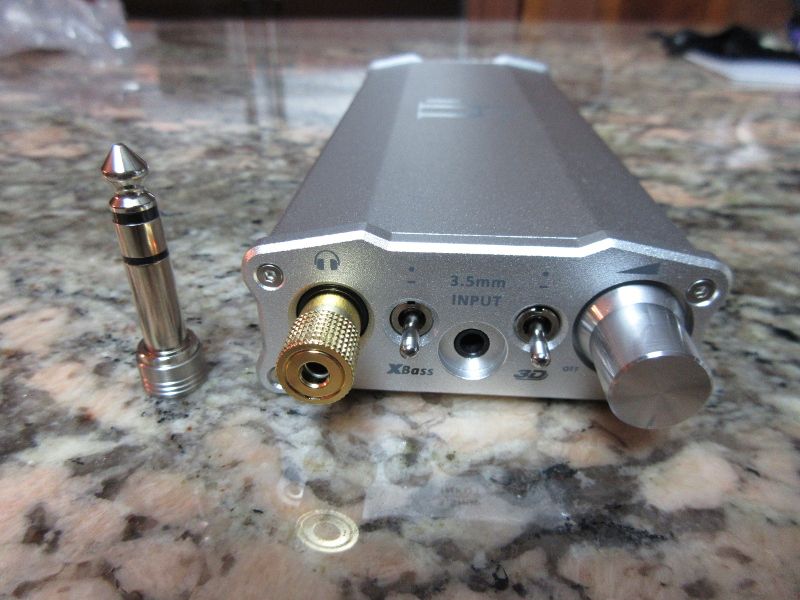
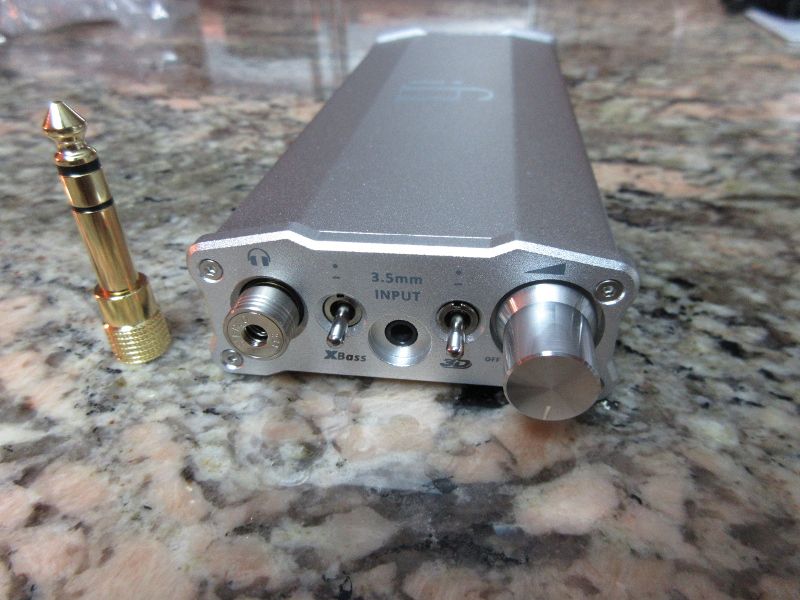
Design.
I already mentioned that from the first look Micro iDSD design reminded me of a car amp unit. It looks very clean with all aluminum body which probably great for heat dissipation and EMI shielding, and slopped edges along the sides for stacking other iFi units on top of each other. When you visit iFi website, you will find that all of their products have the same universal shape and uniform aluminum look. Weighting a little over 300g and with dimensions of 177mm x 67mm x 28mm, Micro looks a little bulky for a portable use, but next to my Note 4 I quickly realized that it’s only a little bit longer in comparison. You do feel heft of the unit, but it’s manageable. As many have mentioned this already, Micro iDSD is transportable rather than portable.
Starting with a “faceplate”, you will find 1/4” headphone jack all the way to the left, far away from an analogue volume control pot which is on the right. Volume knob also turns the power on/off with a click as you turn it clockwise. Also, there is LED light through a small pinhole on the top of Micro where the LED color indicates different audio formats as well as battery charging status. My only comment here is that I wish the knob would be a little more textured (like a fine diamond cut) to enhance the grip which can get a bit slippery. I really like that headphone jack and volume pot were far apart, unlike in Nano iDSD where they are next to each other causing a bit of an obstruction with headphone cables that use thicker connector housing. In the middle of the faceplate you have 3.5mm audio signal input for a direct amplification of the analog signal (from HO). To the Left/Right of this Input you have 2 high quality toggle switches, XBass for bass extension and 3D for holographic sound expansion – more about their effect in Sound analysis section of the review.
One thing to keep in mind and something which is not obvious until you read iFi detailed manual, the internal battery (a hefty 4800 mAh) allows two modes of power operation. If you turn the power on before connecting to your source, you will be running in Battery Power mode and not draining the power from the source, also important since some smartphones will not allow usb DAC connection if excessive power drain is detected. Otherwise, if you connect Micro to your source (with usb cable) and then turn the power on – you will be running in USB Power mode while also charging the battery. Just keep in mind, the usb charging from laptop is painfully slow. Either way, you have two different options. Furthermore, Micro’s digital input (USB A port) also has a built-in iPurifier Lite which suppresses the noise from USB power line and conditions the data signal.
This brings us to the rear panel of Micro where you will find USB-A connector all the way to the right – the digital data input feeding into the internal DAC. It was a bit strange not to find a more traditional USB-B connector, but the convenience of a straight USB-A allows a direct connection with USB OTG adapter to pair up with a smartphone or a tablet. In a portable setup you want to have as little as possible cable interconnects to keep it clean, and in this case you can just use a very short USB OTG adapter for Android devices or camera kit adapter for Apple devices. With other included cables and adapters you have different options to connect to your computer or to use an adapter so you can switch to your aftermarket high quality digital audio cables.
Next to USB input you have a Line Out which bypasses the internal amplifier and sends the signal from DAC to L/R RCA connectors. That output could be connected to another external amplifier or receiver. This Line Out output is actually configurable where underneath of Micro there is a switch allowing selection between Direct (0dB) or Pre-Amplifier (6dB) modes. Next to Line Out you have SPDIF Coaxial combined with Optical port which works either as Input or Output – this socket is auto-switching. When USB audio signal is connected, this port functions as SPDIF Coaxial Output. Then, when USB audio signal is disconnected, this port functions as SPDIF Coaxial or Optical Input. Due to combined nature of this port, optical Input uses 3.5mm mini-Toslink connection thus a reason why iFi included one Toslink mini adapter plug. Basically, if you want to use your DAP as a transport to feed the digital signal into Micro’s DAC/amp, this is a way to go, and if your source supports Toslink optical signal – it’s the best choice over a coax cable.
Moving along the left side of Micro, you will find USB-A port which is only intended for SmartPower Charging, supporting 5V at 1.5A to charge your smart device. On the other side you will find 3 different slide switches. To make it stand out, the red switch corresponds to PowerMod gain with ECO (2V, 250 mW @16 ohm), Normal (4V, 1W @16 ohm), and Turbo (8V, 4W @16 ohm). That is quite a spread allowing to drive anything from efficient to power hungry headphones. Of course, the gain mode selection will have an effect on the battery life, where it's estimated to get close to 12hrs (in ECO mode) down to 9hrs (in Normal mode) reduced to 6hrs (in Turbo mode). And if that wasn’t enough, underneath of Micro there is another power adjustment called IEMatch for sensitive IEMs with Off (0dB), High Sensitivity (12dB), and Ultra Sensitivity (24dB) attenuation adjustment. I’ve never seen this level of micro-adjustment to accommodate anything and everything under the sun! In addition to that, next to the gain PowerMode switch you will also find Polarity selection switch (for digital signal source), and a Digital filter to switch between Standard, Minimum Phase, and Bit-Perfect modes.
You can definitely see that iFi team put a lot of thought into the design and flexibility of controls where you don’t need any external software and can adjust and change all these modes of operation straight from the unit. Overall, it wasn’t just a high quality material used in the design of the body, but also the selection of toggle and slider switches that felt solid and durable.
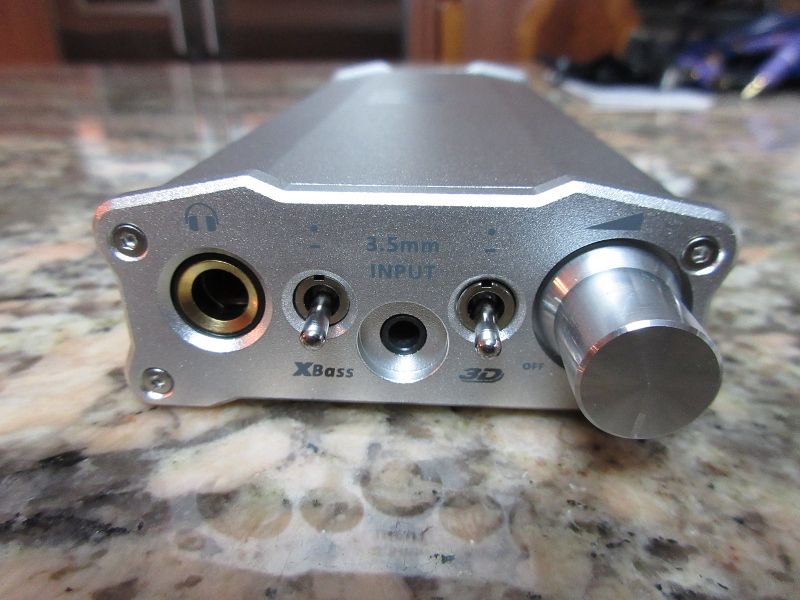
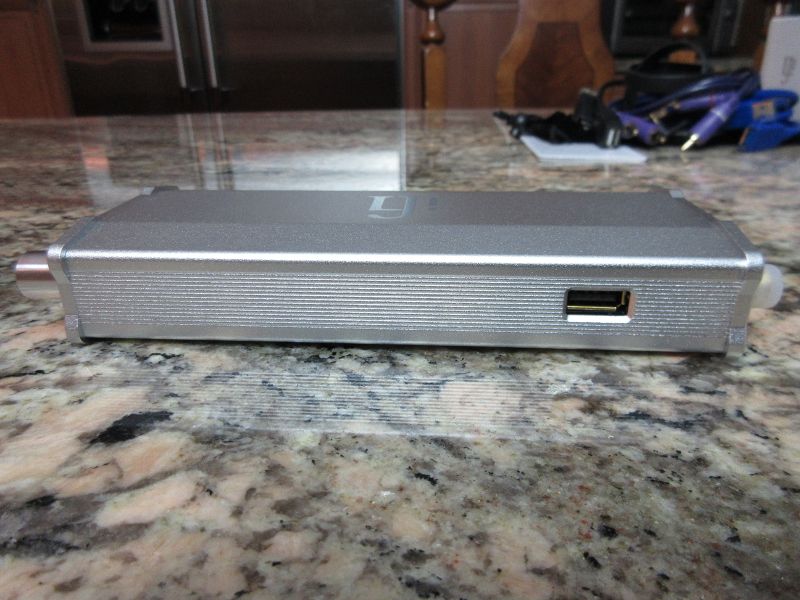
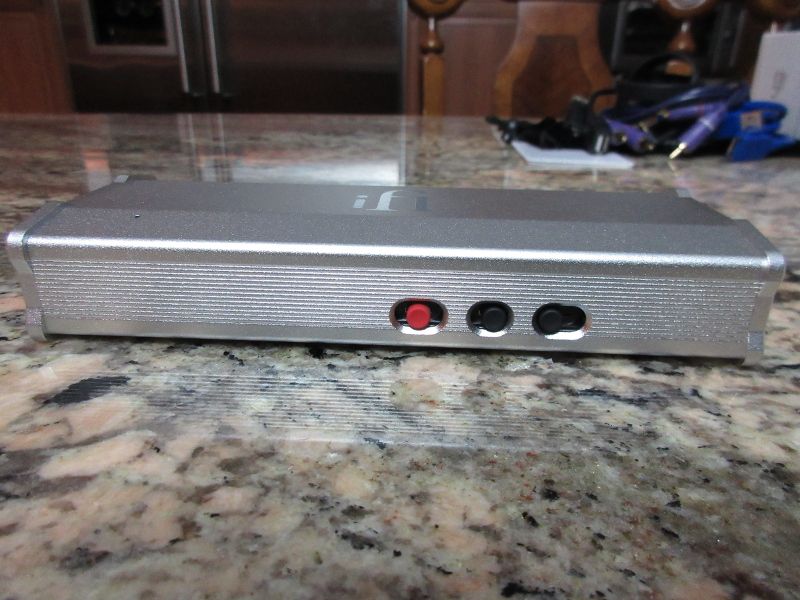
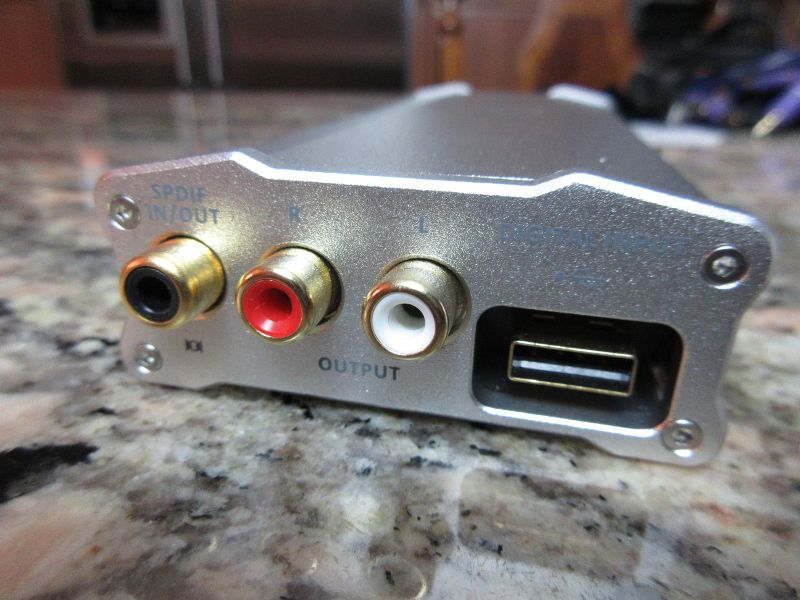

I’m probably starting to sound like a broken record every time I mention about my preference of a portable audio setup where all I need is a small pocket-able DAP and a pair of IEMs for listening on the go. But as a reviewer, I try to be more open-minded and step outside of the portable gear circle to get my feet wet exploring full size headphones, portable and usb DACs/amps and even some desktop DACs/amps. Desktop setup for me is a real stretch because when I’m ready to sit down, my preferred listening environment is our family room couch, when our young ones are finally in bed and my wife next to me getting her daily dose of social media updates (thus a no open-back headphone policy lol!). At that point, I can stack up my DAP with a portable amp or hook up USB DAC to my aging ThinkPad to boost its audio performance.
Obviously, while using my DAP or my laptop as a source, I’m not going to drag a desktop amp on to the couch. Also, using some of my smaller usb DACs offers only a marginal improvement and can’t support all high res sampling rates, plus many of these are underpowered to drive higher impedance or planar magnetic full-size headphones to their full potential. It feels like I have to either compromise or to use different pieces of equipment to meet my needs because I want something that could be reasonably transportable, could drive everything from sensitive monitors to more demanding cans, and will support all popular hi-res formats. Add to this a wish for a great sound quality and not to be at a mercy of noisy 5V usb VBUS. Is this too much to ask? I thought it was until I got a chance to review iFi micro iDSD. Is this too good to be true? Let’s see what I found over the last few weeks of using this true Swiss Army Knife of semi-portable audio gear.
Unboxing.
Greeted with a nice cover shot of all aluminum Micro, my attention zoomed right into the description underneath of it with “Octa-Speed DSD512, Double-Speed DXD, and PCM 32bit/768kHz”. You know right away this is going to be one serious piece of audio equipment with some major horse power under the hood. As I continued with my tour of the box exterior, turning it on the side revealed more details about Dual-Core Burr Brown chipset supporting True Native DSD and Bit Perfect DXD/PCM, a powerful 8Vrms/4W (into 16 ohm) output, 3D holographic sound system and XBass effects, and even 1.5A external charging port for your smartphone or tablet. But wait till you get to the back of the box and start reading every bullet in the Technologies and Specifications list underneath of a detailed drawing of Micro from every side. To describe it as “impressive” would be an understatement, and the only thing missing in there was a kitchen sink, and that was probably because they ran out of room.
Even before getting my hands on it, I was already feeling overwhelmed trying to decide what I am going to test first when I get Micro out of the box. The box was inside of the outer sleeve with all the printed info, and sliding it off revealed an all white “apple” quality cardboard box with silver iFi letters on top. With a cover off, now I was able to see Micro in all its glory, wedged inside of a secure foam cutout. My first impression was “Wow!!!” It looked bigger than I expected and had a shape reminding me of a car amp unit. I also felt a very solid aluminum shell and a noticeable heft as I removed Micro in order to get to the bottom of the box where all the accessories were stored across two partitioned sections. While in many cases I appreciate the actual experience of unboxing the product, here my highlight was reading a detailed Spec list which builds up the anticipation!






Accessories.
As much as I couldn’t wait to get to Micro, I had to set it aside and move on to examine the accessories. First of all there was a detailed manual, very important in this case since Micro is full of surprises you can easily miss. Then, you have 4 clear rubber stick on bumps to use under the iDSD for additional friction and/or to prevent surface from scratches, and also a semi-transparent rubbery pad to use with iDSD when you stacking it with another device (smartphone, tablet, DAP, etc). You also get 1/4” to 3.5mm adapter since iDSD has 1/4” HO. With all aluminum/silver body finish I personally didn’t like the look of a gold adapter sticking out of the socket, so I found a shallow silver one as a replacement (PC-234S model). Also, iFi included a velour drawstring storage/protection pouch and 2 mounting rubber bands to secure transport/source devices to Micro.
Moving on to cables, you will find a dual RCA high quality cable, and I really mean HIGH quality! You also get a short 3.5mm to 3.5mm interconnect cable to use Micro as amplifier from your source. Next is the USB-A to USB-B socket adapter cable and another short adapter to accommodate Micro’s USB-A connector on the back since many audio digital cables are usb-a to usb-b. Also, you get a high quality USB-A socket to USB-A connector cable to attach Micro directly to you computer. And if that wasn’t enough, they also included Toslink to mini 3.5mm optical adapter since Micro’s Coax port is combined with optical input. Only one adapter was included, though I would have preferred a pair in order to transform a common Toslink cable.
This was a very impressive collection of accessories, and I’m not talking about cheap fillers, but the actual high quality cables and other goodies. The only thing I would add is a short OTG adapter cable, typical USB-A socket to micro-USB connector for Android devices, and a camera adapter kit cable for iPhone/iPad devices. Micro supports USB OTG connection and with USB-A connector on the back you can go directly with a short adapter cable to your smartphone or tablet.







PC-234S replacement 1/4" to 3.5mm adapter (not included, search for it on eBay):


Design.
I already mentioned that from the first look Micro iDSD design reminded me of a car amp unit. It looks very clean with all aluminum body which probably great for heat dissipation and EMI shielding, and slopped edges along the sides for stacking other iFi units on top of each other. When you visit iFi website, you will find that all of their products have the same universal shape and uniform aluminum look. Weighting a little over 300g and with dimensions of 177mm x 67mm x 28mm, Micro looks a little bulky for a portable use, but next to my Note 4 I quickly realized that it’s only a little bit longer in comparison. You do feel heft of the unit, but it’s manageable. As many have mentioned this already, Micro iDSD is transportable rather than portable.
Starting with a “faceplate”, you will find 1/4” headphone jack all the way to the left, far away from an analogue volume control pot which is on the right. Volume knob also turns the power on/off with a click as you turn it clockwise. Also, there is LED light through a small pinhole on the top of Micro where the LED color indicates different audio formats as well as battery charging status. My only comment here is that I wish the knob would be a little more textured (like a fine diamond cut) to enhance the grip which can get a bit slippery. I really like that headphone jack and volume pot were far apart, unlike in Nano iDSD where they are next to each other causing a bit of an obstruction with headphone cables that use thicker connector housing. In the middle of the faceplate you have 3.5mm audio signal input for a direct amplification of the analog signal (from HO). To the Left/Right of this Input you have 2 high quality toggle switches, XBass for bass extension and 3D for holographic sound expansion – more about their effect in Sound analysis section of the review.
One thing to keep in mind and something which is not obvious until you read iFi detailed manual, the internal battery (a hefty 4800 mAh) allows two modes of power operation. If you turn the power on before connecting to your source, you will be running in Battery Power mode and not draining the power from the source, also important since some smartphones will not allow usb DAC connection if excessive power drain is detected. Otherwise, if you connect Micro to your source (with usb cable) and then turn the power on – you will be running in USB Power mode while also charging the battery. Just keep in mind, the usb charging from laptop is painfully slow. Either way, you have two different options. Furthermore, Micro’s digital input (USB A port) also has a built-in iPurifier Lite which suppresses the noise from USB power line and conditions the data signal.
This brings us to the rear panel of Micro where you will find USB-A connector all the way to the right – the digital data input feeding into the internal DAC. It was a bit strange not to find a more traditional USB-B connector, but the convenience of a straight USB-A allows a direct connection with USB OTG adapter to pair up with a smartphone or a tablet. In a portable setup you want to have as little as possible cable interconnects to keep it clean, and in this case you can just use a very short USB OTG adapter for Android devices or camera kit adapter for Apple devices. With other included cables and adapters you have different options to connect to your computer or to use an adapter so you can switch to your aftermarket high quality digital audio cables.
Next to USB input you have a Line Out which bypasses the internal amplifier and sends the signal from DAC to L/R RCA connectors. That output could be connected to another external amplifier or receiver. This Line Out output is actually configurable where underneath of Micro there is a switch allowing selection between Direct (0dB) or Pre-Amplifier (6dB) modes. Next to Line Out you have SPDIF Coaxial combined with Optical port which works either as Input or Output – this socket is auto-switching. When USB audio signal is connected, this port functions as SPDIF Coaxial Output. Then, when USB audio signal is disconnected, this port functions as SPDIF Coaxial or Optical Input. Due to combined nature of this port, optical Input uses 3.5mm mini-Toslink connection thus a reason why iFi included one Toslink mini adapter plug. Basically, if you want to use your DAP as a transport to feed the digital signal into Micro’s DAC/amp, this is a way to go, and if your source supports Toslink optical signal – it’s the best choice over a coax cable.
Moving along the left side of Micro, you will find USB-A port which is only intended for SmartPower Charging, supporting 5V at 1.5A to charge your smart device. On the other side you will find 3 different slide switches. To make it stand out, the red switch corresponds to PowerMod gain with ECO (2V, 250 mW @16 ohm), Normal (4V, 1W @16 ohm), and Turbo (8V, 4W @16 ohm). That is quite a spread allowing to drive anything from efficient to power hungry headphones. Of course, the gain mode selection will have an effect on the battery life, where it's estimated to get close to 12hrs (in ECO mode) down to 9hrs (in Normal mode) reduced to 6hrs (in Turbo mode). And if that wasn’t enough, underneath of Micro there is another power adjustment called IEMatch for sensitive IEMs with Off (0dB), High Sensitivity (12dB), and Ultra Sensitivity (24dB) attenuation adjustment. I’ve never seen this level of micro-adjustment to accommodate anything and everything under the sun! In addition to that, next to the gain PowerMode switch you will also find Polarity selection switch (for digital signal source), and a Digital filter to switch between Standard, Minimum Phase, and Bit-Perfect modes.
You can definitely see that iFi team put a lot of thought into the design and flexibility of controls where you don’t need any external software and can adjust and change all these modes of operation straight from the unit. Overall, it wasn’t just a high quality material used in the design of the body, but also the selection of toggle and slider switches that felt solid and durable.






